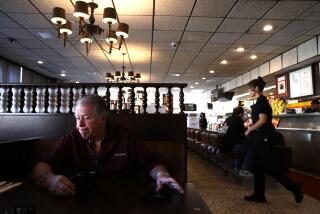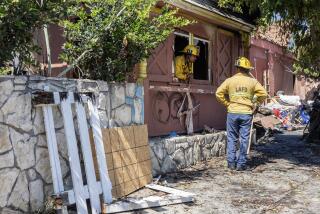Tamale-shaped building at center of preservation dispute

Tamale, camera and giant barrel shaped buildings aren’t hard to find in LA, as long as you’re willing to look. Here are a few examples of programmatic architecture.
Fernando Alarcon doesn’t dwell too much on what it means to be the filling of a tamale.
For four years, Alarcon has worked in a dental laboratory in East Los Angeles on Whittier Boulevard inside a giant green tamale squished between two buildings. Every so often tourists step off a bus holding smartphones and cameras, expecting Alarcon, 42, to regale them with stories about the tamale.
He makes sure to shut the door. Alarcon doesn’t really have a strong opinion about the tamale. He’s jaded about its contours.
“Everyone wants to see it, everyone asks about it,” Alarcon said, befuddled. “To me, it’s normal.”
Built in the 1920s, the building has shed its name like a corn husk several times over the years.
It’s a holdover from a time when the architectural rage was to design retail buildings that reflected the business that occupied the space.
So-called programmatic architecture came to be during the dawn of the car age to help businesses attract the attention of motorists, said Linda Dishman, executive director of the Los Angeles Conservancy.
But over the last few decades, the buildings have disappeared from the streetscape, victims of rising real estate values and changing architectural tastes. A few iconic examples of the form remain, such as the giant Randy’s Donuts in Inglewood and the camera-shaped Darkroom building on Wilshire Boulevard.
Many others have been lost — including the Tail o’ the Pup in West Hollywood (a giant hot dog), and most of the Brown Derby restaurants (a giant hat).
“It’s sort of like building as signage ... they were trying to advertise to the car culture,” Dishman said.
The heyday of the movement was the late 1920s and early 1930s. Eventually, she added, the “trend sort of faded away” and was replaced with a cleaner modern architecture sometimes known as Googie, after a famous Hollywood coffee shop. This week, the City Council declared a classic example of Googie, the Norm’s Restaurant on La Cienega Boulevard, a historic landmark as activists work to preserve it.
There is also an effort to preserve the tamale.
Los Angeles architecture buff Richard Schave argues that the tamale is a cultural landmark because it’s one of the few survivors of its kind.
“A lot of it has been taken down,” he said.
Schave and his wife, Kim Cooper, found the tamale so architecturally appetizing that they made it part of their Eastside Babylon bus tour. The two, who co-founded the Esotouric tour company, will bring visitors every three or four months to one of their favorite spots in Los Angeles.
When the property owners decided to put the tamale on the market two years ago, Schave and Cooper quickly took to their website to express their fears that it would be gobbled up by development.
Los Angeles County is now considering a historic preservation ordinance that would allow people to nominate properties in unincorporated Los Angeles County — such as the tamale — as landmarks.
“Until that ordinance is effective, we don’t have a way to designate landmarks or historic districts,” said Phillip Estes, principal planner for the county. “If it’s a designated landmark then there are provisions to protect it.”
The Board of Supervisors has already done a first reading of the ordinance and directed county counsel to prepare the final ordinance for consideration.
“It’s such a great Los Angeles story that this place still survives,” Cooper said. “This is important and it’s not something that should just disappear without a word.”
Not everyone agrees. The manager for Sky Realty Investments LLC, which owns the property, said it does not want the building to be designated as historic. Consuelo Aguirre said that would make it hard to sell the property.
“I don’t want it to go historical because it doesn’t look that appealing,” she said, adding that she met with county officials a few years ago. “I said, ‘If you like the building so much just put it somewhere else. Just take it. I’ll give you the building’ ... I don’t understand why they want to make it a historical building. I’m really opposed to that.”
Some of the neighbors of the tamale — which is covered in a green paint of indeterminate age — said they are not impressed with it.
“It’s ugly,” said Heidy Martinez, 46, whose home is on the other side of a wall from the tamale. She’s noticed people stopping to snap pictures with the tamale.
“I would never take a picture with it,” Martinez said.
But others can’t resist the giant tamale. Six years ago, Alarcon said, tourists paid a visit to the hair salon next door. One man insisted on getting his hair cut inside — perhaps because he could then say he had his hair trimmed inside a tamale.
“It’s like if you go to the Statue of Liberty — you want to buy a miniature statue,” Alarcon said. “Something to say you were there. This was his souvenir.”
Severo Arreola, who owns a nearby business, uses the building as a reference point. He tells potential clients: “We’re next to the tamal.”
Some people see a tamale, but others see different objects. Some see a fish, a chile or a candy waiting to be unwrapped.
Albert Magana, 26, a postal worker, said the building’s oddly Stone Age look “reminds me of the Flintstones.” He said he had no idea it was a tamale.
Arreola said that with a bit of luck it may return to its roots one day.
“I’d love to have a tamaleria here,” Arreola said with a smile. “I love tamales.”
ALSO:
Tail O’ the Pup, the landmark L.A. hot dog stand, homeless
Eldon Davis dies at 94; architect designed ‘Googie’ coffee shops
Dunkin’ Donuts developer agrees to save Long Beach’s signature rooftop pastry
More to Read
Sign up for Essential California
The most important California stories and recommendations in your inbox every morning.
You may occasionally receive promotional content from the Los Angeles Times.











